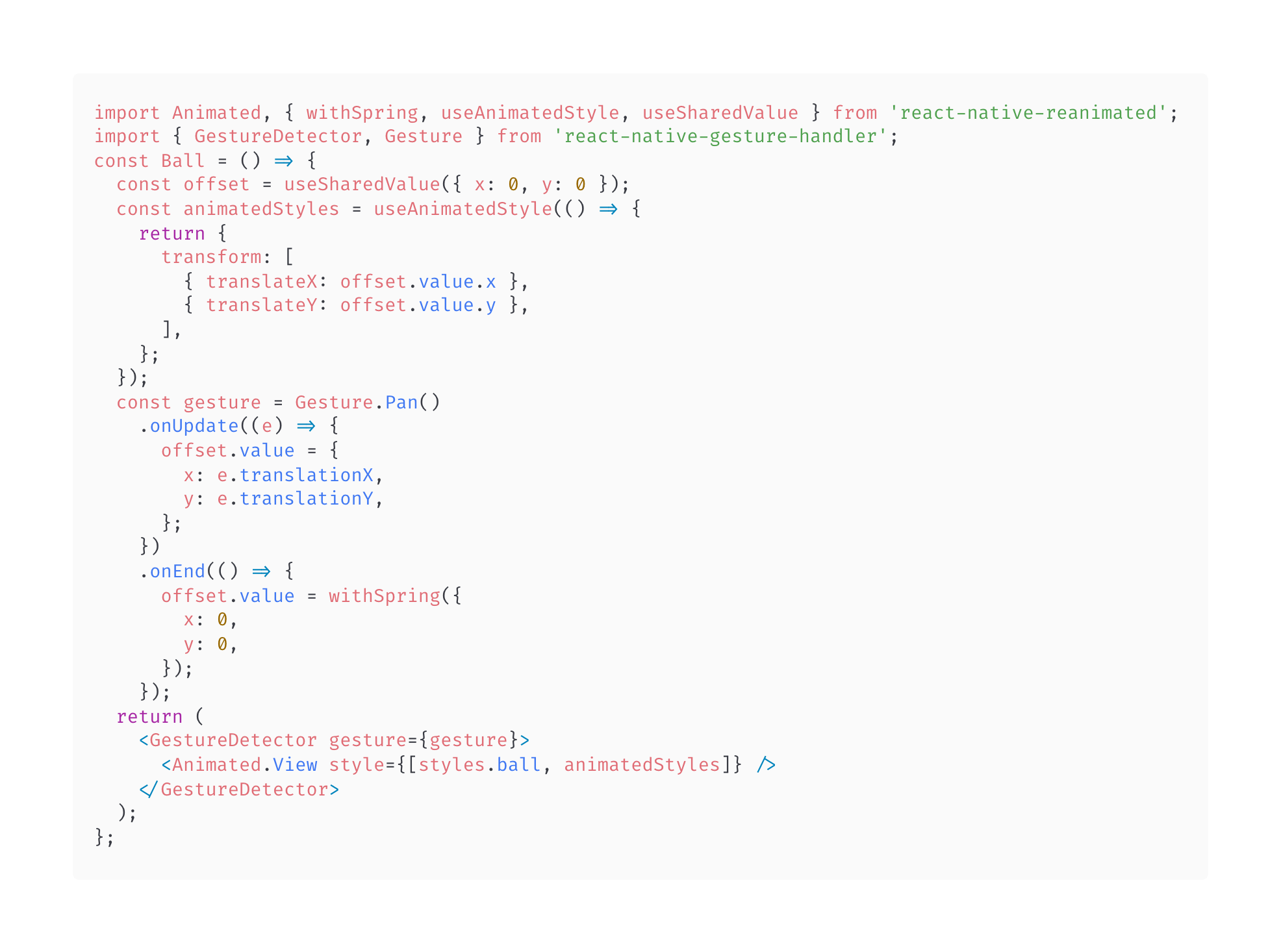Animation in React Native
What's the problem of this demo?
React Native Render, Commit and Mount

-
Render: React executes product logic which creates a React Element Trees in JavaScript. From this tree, the renderer creates a React Shadow Tree in C++.
-
Commit: After a React Shadow Tree is fully created, the renderer triggers a commit. This promotes both the React Element Tree and the newly created React Shadow Tree as the “next tree” to be mounted. This also schedules calculation of its layout information.
- Mount: The React Shadow Tree, now with the results of layout calculation, is transformed into a Host View Tree.
Threading Model
- UI thread (often called main): The only thread that can manipulate host views.
- JavaScript thread: This is where React’s render phase, as well as layout, are executed.
Features:
- thread safe and synchronous
- immutable data structures
- enforced by C++ “const correctness” feature
- every update in React creates or clones new objects
Render in a JS Thread (most common scenario)

Render in the UI Thread (high priority event on the UI Thread)


Initial Render

function MyComponent() {
return (
<View>
<Text>Hello, World</Text>
</View>
)
}



- Layout Calculation
- yoga
- the layout calculation of some components depend on the host platform (e.g. Text, TextInput, etc.).
- Tree Promotion
- New Tree → Next Tree
- The “next tree” mounts on the next “tick” of the UI Thread


React Shadow Tree -> Host View Tree
- Tree Diffing and View Flattening
- Computes the diff between the “previously rendered tree” and the “next tree” entirely in C++.
- Tree Promotion (Next Tree → Previously Rendered Tree)
- View Mounting. This step executes in the host platform on UI thread.
React State Updates
function MyComponent() {
return (
<View>
<View style={{ backgroundColor: 'red', height: 20, width: 20 }} />
<View style={{ backgroundColor: 'blue', height: 20, width: 20 }} />
</View>
)
}

Assume that as the result of a state update in JavaScript product logic, the background of the first nested
<View>
<View style={{ backgroundColor: 'yellow', height: 20, width: 20 }} />
<View style={{ backgroundColor: 'blue', height: 20, width: 20 }} />
</View>
Let’s explore each phase of the render pipeline during a state update.


Let's assign T to the “previously rendered tree” and T' to the “new tree”:
- CloneNode(Node 3, {backgroundColor: 'yellow'}) → Node 3'
- CloneNode(Node 2) → Node 2'
- AppendChild(Node 2', Node 3')
- AppendChild(Node 2', Node 4)
- CloneNode(Node 1) → Node 1'
- AppendChild(Node 1', Node 2')

- Layout Calculation
- Similar to Layout Calculation during Initial Render
- Tree Promotion (New Tree → Next Tree)
- Similar to Tree Promotion during Initial Render.

- Tree Promotion (Next Tree → Rendered Tree)
- Tree Diffing
- diff between the “previously rendered tree” (T) and the “next tree” (T')
- UpdateView(Node 3', {backgroundColor: '“yellow“})
- View Mounting

Now we can answer the question:
What's the problem of first demo?
- This animation will be handled by the Javascript thread.
- Animation will get stuck because it executes rendering procedure(render, commit, mount) in every frame
- State updates are asynchronous.
- This means in our case that these updates might not come at the time we think they will.
React Native Animation (Official)
Using the native driver
const translateX = useRef(new Animated.Value(0)).current
//...
Animated.timing(translateXRefValue, {
toValue: 200,
duration,
easing: Easing.inOut(Easing.linear),
useNativeDriver: true,
}).start()
- Run in UI thread
- without having to go through the bridge on every frame
- new Animated.Value(0)
- useNativeDriver: true
- useNativeDriver property will default to false for legacy reasons
- Once the animation has started, the JS thread can be blocked without affecting the animation.
Weex bindingx
Problems of Official React Native Animation
- lock in 60Hz
https://github.com/facebook/react-native/issues/29333 - not friendly for animation with gesture
- apis are complex
About Frame Per Second(pfs)
Watch Videos
60fps Record Video
vs
120fps Record Video
Why movie 24fps is ok, but 24fps in game is not ok?
https://www.zhihu.com/question/21081976
-
When you pause a movie, you can see the image is blur
-

React Native Reanimated
https://docs.swmansion.com/react-native-reanimated/
easily create smooth animations and interactions that run on the UI thread.

- Define animatable elements.
- Shared values are a driving factor of all animations
- useSharedValue hook
- Modify shared values using animation functions like withTiming
React Native Reanimated Api
https://docs.swmansion.com/react-native-reanimated/docs/fundamentals/getting-started/
Watch Videos Gesture Demo

Bonus
Spring Animation
https://gaohaoyang.github.io/2021/03/01/spring-animation-framer-motion/
Summary
- React Native Render, Commit and Mount
- Threading Model
- React Native Animation (Official)
- About Frame Per Second(pfs)
- React Native Reanimated
- Spring Animation
Thanks
Haoyang Gao
2023.11.17